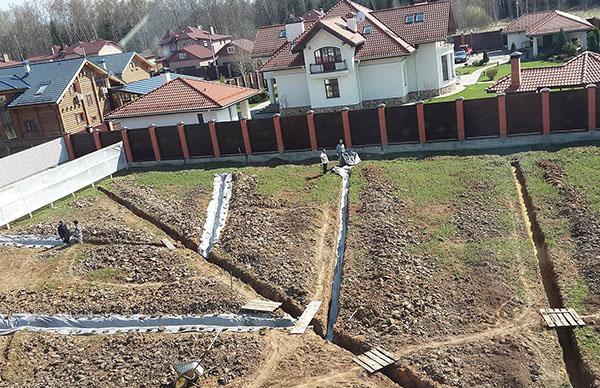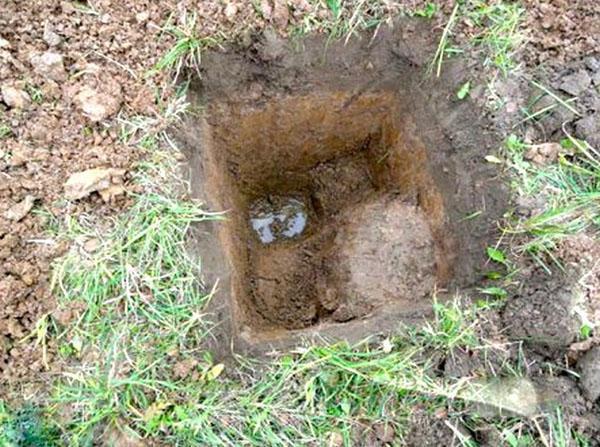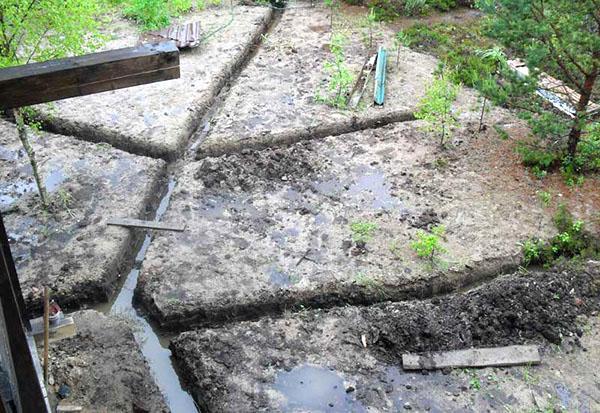How to make a reliable drainage system on the site with your own hands
 A low-lying area can create many problems for its owners. In waterlogged soil, the foundation of the house collapses faster, plant roots rot from lack of air. Fertile soil in a short time turns into clay unsuitable for agriculture, because the lighter humus washed out into water bodies. Similar problems are solved by a site drainage device.
A low-lying area can create many problems for its owners. In waterlogged soil, the foundation of the house collapses faster, plant roots rot from lack of air. Fertile soil in a short time turns into clay unsuitable for agriculture, because the lighter humus washed out into water bodies. Similar problems are solved by a site drainage device.
The installation of such a reclamation system is not difficult, but all the work is quite laborious, so first you should make sure that the problem lies precisely in the high level of groundwater flow, and not in other errors of agricultural technology.
Read also the article: drainage around the house!
How to determine the level of groundwater

- The plot is located on a slope. Thawed or storm water will erode the soil, carrying with it a layer of humus. The problem is solved by digging transverse drainage ditches.
- The site is located in a lowland. In this case, moisture accumulates directly on it. With prolonged rains or amicable melting of snow, the soil will swamp and acidify, and the buildings will collapse from mold. In this case, it is necessary to install drainage channels around the entire perimeter of the site and around the foundation.
- There is no obvious difference in elevation on the site, but in flood and rainy weather there is still water on it. It has nowhere to drain, so moisture is slowly absorbed and at times appears on the surface in the form of long-lasting puddles.
The latter option is typical for lowland lowlands with an extensive network of large and small rivers. He is well known to the owners of land plots in the floodplains of rivers.
If there are no obvious signs listed above, but plantings and buildings still suffer from high humidity, you should pay attention to the condition of the lawn and trees. If the lawn periodically looses, and mature trees die for no apparent reason, the problem most likely lies in high-standing waters.
Dig a hole 0.5–0.7 m deep and after a while check to see if water is getting into it. If you saw the water, then the level of its occurrence is less than 1 meter, and drainage of the summer cottage will definitely be needed.
Drainage types
 Drainage is a system of shallow ditches used to drain groundwater. A drainage system installed in accordance with all the rules can significantly reduce their level. After its installation, the problems of root decay in trees, the appearance of mold in the underground and water in the cellar disappear.
Drainage is a system of shallow ditches used to drain groundwater. A drainage system installed in accordance with all the rules can significantly reduce their level. After its installation, the problems of root decay in trees, the appearance of mold in the underground and water in the cellar disappear.
There are two types of drainage systems - surface and deep.
The first option is the easiest way to drain precipitation. It is a complex of interconnected trenches dug along the perimeter of the land plot at a slope. With their help, you can relatively quickly, at minimal cost and effectively divert melt and rainwater into a special drainage basin, which is arranged in the lowest part of the site. Waste from the catchment is discharged into the storm sewerage, or used for irrigation. Small volumes of liquid evaporate quickly on their own.
 Installation of a deep system is more difficult, but superior to a surface system in the following cases:
Installation of a deep system is more difficult, but superior to a surface system in the following cases:
- groundwater rises above half a meter from the surface;
- the site is on a slope;
- the soil is dominated by clay.
Deep drainage differs from surface drainage by the presence of drains - pipes with frequent holes through which water is collected, as well as wells, sand traps and other technological elements.
Deep drainage of the site is completely hidden underground and does not spoil the landscape.
Installation of a deep drainage system
 It is not difficult to make a water drainage system from the site yourself, but you need to plan its installation before the stage of building the foundation and laying the garden. First, preparatory work is carried out. They prepare a project and note in it:
It is not difficult to make a water drainage system from the site yourself, but you need to plan its installation before the stage of building the foundation and laying the garden. First, preparatory work is carried out. They prepare a project and note in it:
- elevation differences on the site;
- the location of the lowest point;
- drainage grooves;
- places for wells;
- pipe laying depth.
It is necessary to carefully calculate the height of the horizontal pipes in advance.
For effective drainage to work, the minimum slope should be at least one centimeter per linear meter of the pipe.
Upon completion of the preparatory work, all the necessary tools, materials should be prepared and their number should be calculated. The standard set includes:
- perforated pipes of a suitable size;
- drainage wells;
- drain connection accessories - various couplings and fittings;
- geotextile;
- sand and crushed stone.
On sale there are pipes for laying drainage on the site with your own hands. Suitable asbestos-cement, polyvinyl chloride, ceramic. Popular made of modern porous materials - plastoconcrete, expanded clay glass. Water seeps through the pores, and small solid particles do not pass, that is, they do not clog the system.
Also prepare tools in advance: bayonet and shovels, ground wheelbarrows, hacksaw for cutting pipes, building level.
Next, mark the location of all elements on the ground. Then, in marked places, trenches are dug with a depth of at least 0.7 m and about half a meter wide. When all channels have been dug, make sure they have the correct slope throughout. The places where the wells will be located are deepened more.
 When all the trenches are ready, the bottom of the grooves and wells is rammed, covered with a layer of sand and compacted again. Then geotextiles are laid in them in such a way as to wrap it around the pipe with a margin.
When all the trenches are ready, the bottom of the grooves and wells is rammed, covered with a layer of sand and compacted again. Then geotextiles are laid in them in such a way as to wrap it around the pipe with a margin.
 Crushed stone is poured onto the geotextile and pipes are laid so that the holes are at the bottom. The whole system is connected, the slope is checked again and finally covered with rubble. It must cover the pipes completely. Then the free edges of the fabric are wrapped inward. The result should be a kind of roll with a pipe in the center.
Crushed stone is poured onto the geotextile and pipes are laid so that the holes are at the bottom. The whole system is connected, the slope is checked again and finally covered with rubble. It must cover the pipes completely. Then the free edges of the fabric are wrapped inward. The result should be a kind of roll with a pipe in the center.
Layers of fabric, sand and gravel prevent siltation of the system, significantly extending its life.
Drainage (revision) wells are installed at the joints of the pipes. They are designed for condition monitoring and cleaning. They are mounted just below the pipe level. The upper part has a removable cover for easy maintenance.
After assembling pipes and wells into a single complex, a collector well is installed at the lowest part of the site. It is the main reservoir for waste water. Most often, collectors are made of reinforced concrete rings, but if desired, they purchase and install ready-made plastic ones. From the collector, it is necessary to provide for a drain into the storm sewer or reservoir.
How to hide drainage underground and decorate the site at the same time
 This is the installation work for the device drainage in the country with their own hands can be considered complete. Now the entire system should be filled up in order to hide it completely underground. Filled trenches are covered with turf. In the future, flowers or any garden crops with a shallow root system are planted in this place. The grooves filled with large marble chips look interesting. Such elements of landscape design will decorate the site and will not let you forget the location of the pipes in case of repair work.
This is the installation work for the device drainage in the country with their own hands can be considered complete. Now the entire system should be filled up in order to hide it completely underground. Filled trenches are covered with turf. In the future, flowers or any garden crops with a shallow root system are planted in this place. The grooves filled with large marble chips look interesting. Such elements of landscape design will decorate the site and will not let you forget the location of the pipes in case of repair work.
The drainage system of waters is usually combined with gutters.To do this, a gutter is mounted that connects the drain with the nearest well, or a storm water inlet is installed.
 A closed drainage device at a summer cottage is not the easiest, but the most effective way to lower the groundwater level. Some of the steps may seem like too much time consuming or painstaking, but the result in the form of a dry foundation and a healthy garden will delight for many years.
A closed drainage device at a summer cottage is not the easiest, but the most effective way to lower the groundwater level. Some of the steps may seem like too much time consuming or painstaking, but the result in the form of a dry foundation and a healthy garden will delight for many years.
Hello. The drainage system must also be done wisely, so that nothing will flood later. We did it ourselves for the first time and nothing good came of it, we had to contact the specialists at the “drainage / drainage system company”. In a short time, we did everything right, for which we are very grateful. All work was done very high quality, really a master of his craft. So it is better to contact the specialists right away.